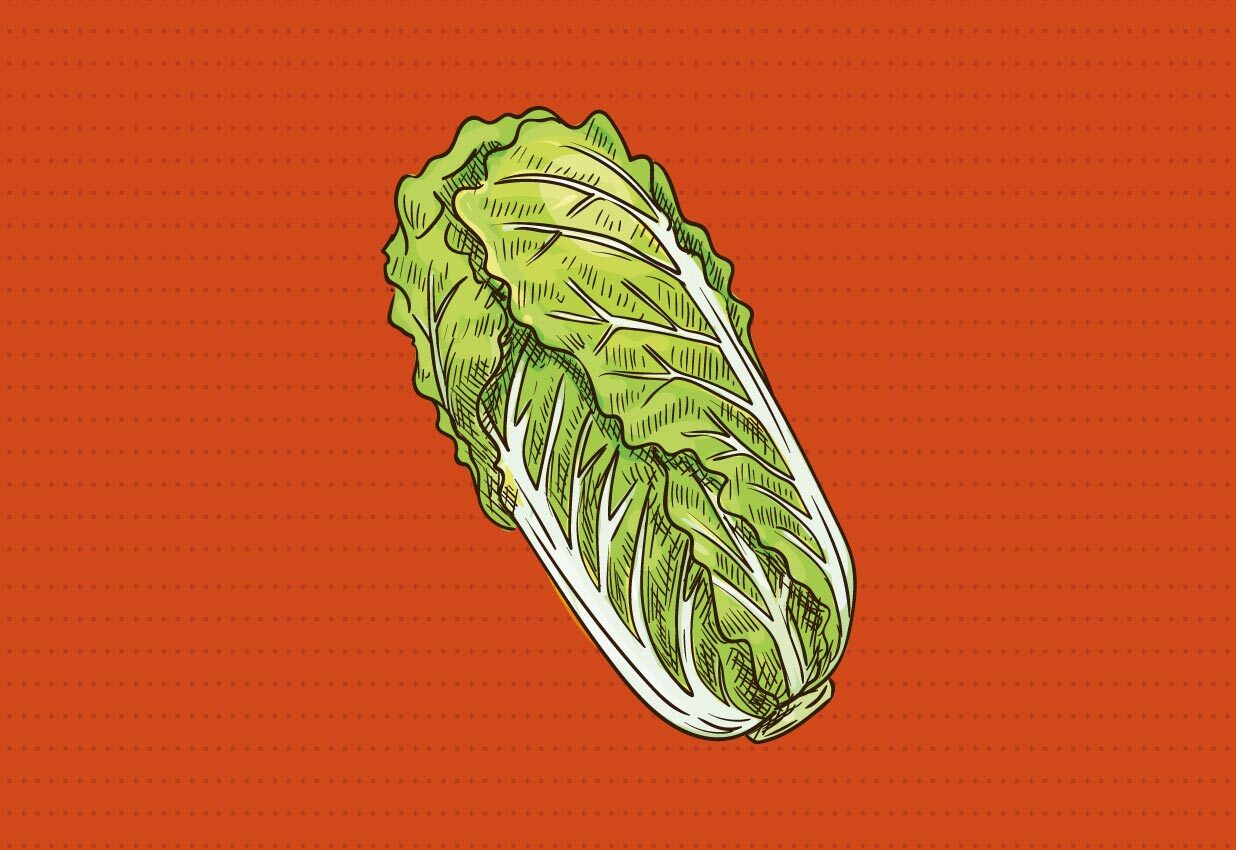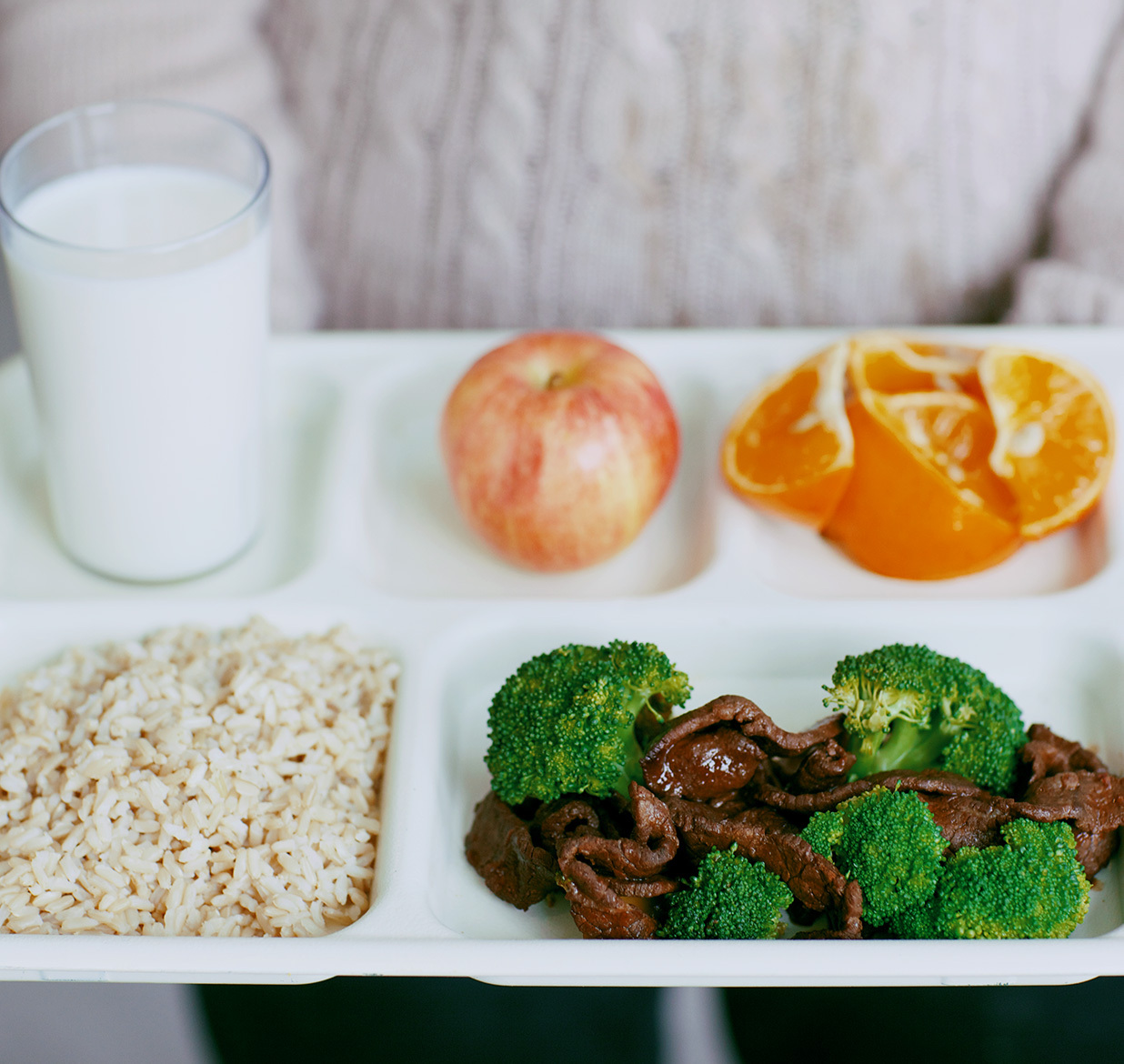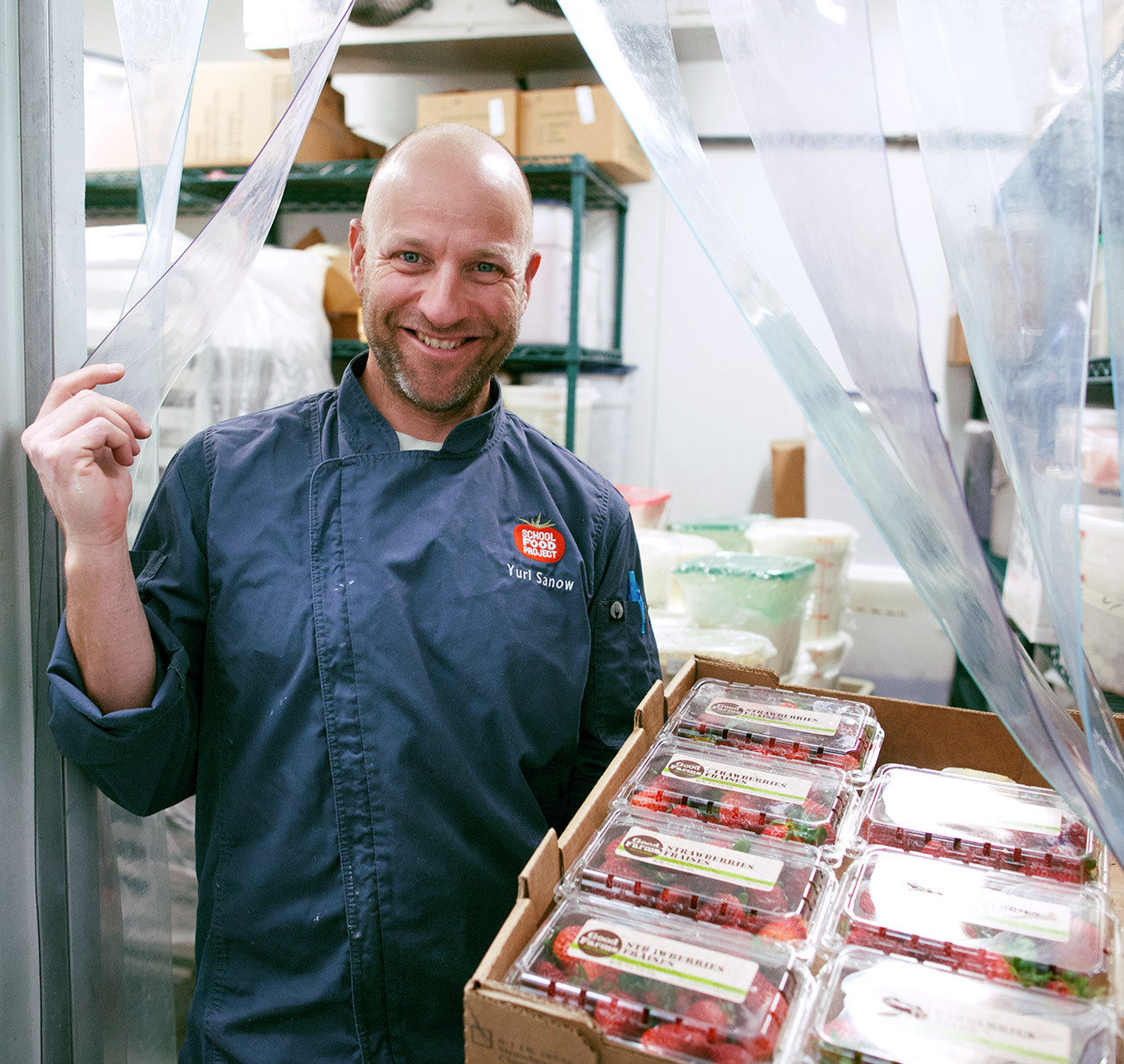
Central Kitchen Case Study: Design & Construction
Case study quick links: intro & planning, benefits, design & construction (current page), menu & procurement, staffing, and community engagement.
Design Considerations
There are many design considerations to take into account when planning your central kitchen. For example, your menu and food safety practices should influence design decisions.

Central Kitchen Case Study: Design & Construction
Case study quick links: intro & planning, benefits, design & construction (current page), menu & procurement, staffing, and community engagement.
Design Considerations
There are many design considerations to take into account when planning your central kitchen. For example, your menu and food safety practices should influence design decisions.

Design & Budgets
The bond was passed in November 2014, but it took many iterations of the plans and budgets before ground was broken in April 2019 for what is now referred to as BVSD’s Culinary Center (CC). BVSD selected Ricca Design Studios and JHL Constructors for the CC build. The Master Plan and budget for the BVSD Administrative Campus project was developed in 2014. Though the bond allocated $10 million for the Culinary Center, as each phase of architectural design progressed, adjustments had to be made to address budget concerns.
Here’s a brief, high-level overview of the plan evolution:
The original approach was to remodel a portion of the existing warehouse as well as provide a small addition to accommodate 25,400 square feet of kitchen space.
Further reviews of the required kitchen areas indicated that in order to accommodate the projected lunch counts, the overall building square footage would need to be approximately 33,000 sf. It was determined that utilizing the existing warehouse was no longer feasible and a new building would be required.
Each phase of design required virtual engineering reviews (VE), to evaluate the planned construction methods and/or materials. VE reviews balance the cost, performance, reliability, maintainability, aesthetic, safety, and security criteria of various methods and materials. The VE reviews continued throughout the entire project of design to construction.
Throughout the Design, Schematic, and Construction phases, the project team had to identify ways to contain costs despite the impact of material cost increases due to steel and aluminum tariffs, and the escalation of construction costs in the Greater Denver Metro area. To reduce costs, the overall production capacity was reduced to 17,000 meals from the original 20,000.
The project team also decided to use less expensive options in the mechanical system, for example in choices of HVAC systems, to balance the increased costs to the structural system due to the increased costs of steel and aluminum. One of the key savings was shifting the building approach to a pre-engineered metal building.
Installing the freezer, refrigerator, and dry storage areas adjacent to the CC rather than within the walls further increased savings.
To allow for future flexibility and production growth, the dry storage area was constructed with walk-in refrigerator panels but without compressors so that it could be converted to refrigerated storage in the future. In addition, the Teaching Kitchen, Test Kitchen area and some of the CC equipment locations and square footage are accounted for in the square footage and location but will not be completed until funds are available.
The project team saved more than $1.8 million through the VE process over the last two years, but the final budget remained approximately $3 million over budget. The Board of Education approved covering that shortage through the Bond Program. As the construction progresses, Cooper and her team continue to face daily decisions to keep the project on financial track, while still maintaining the integrity of the design.
Below: Blueprint - Level 1 Key Plan for Culinary Center

Central Kitchen Tour

Menu Driven Design
A consolidated production and warehouse facility supports many themes that the FSD has been pursuing for years:
- scratch-cooking driven by local and regional procurement featuring green procurement practices,
- a home for the Weekend Bag Program,
- and the ability to respond to the growing demands of contract meal programs for regional charter schools.
To continue to educate the public about the SFP, the CC will also feature a café where it will sell meals to the adjacent Education Center employees as well as the general public. The CC will also house a Teaching Kitchen, which is being fundraised for now. The BVSD Teaching Kitchen will serve as a community hub, bringing people together for culinary literacy workshops, vocational learning and hands-on training for students and staff.

Since 2009, the FSD has been building capacity to use fresh, raw meats in its program. Through their procurement work, they have also been able to increase the amount of locally produced fresh beef and chicken. But due to the limited storage capacity at the warehouse and storage and cooking facility at the Regional PK kitchens, they have been reliant on the frozen raw or frozen pre-cooked chicken, beef, turkey and pork procured through the USDA Commodity Foods program and prime vendors.

Since 2009, the FSD has been building capacity to use fresh, raw meats in its program. Through their procurement work, they have also been able to increase the amount of locally produced fresh beef and chicken. But due to the limited storage capacity at the warehouse and storage and cooking facility at the Regional PK kitchens, they have been reliant on the frozen raw or frozen pre-cooked chicken, beef, turkey and pork procured through the USDA Commodity Foods program and prime vendors.
The FSD’s goal of procuring and using only fresh, raw meats could only be realized through a CC. The FSD team conducted research and in-person visits to more than 7 large-scale school and commercial central kitchens around the country to see what equipment and methodology might be currently in use for scratch production. Though none of the facilities were close enough to model for BVSD’s design, the process was valuable to see some equipment in action that the FSD determined to be the best fit for their plan.
Sous Vide
The FSD team decided to design the facility around use of the sous vide cook-chill process. “Sous vide” is French for the term “under vacuum”. Known as a precision cooking method, the ingredients are vacuum-sealed and cooked slowly at precise temperatures in a circulating water bath. The benefits include improved moisture and flavor, even cooking, greater cooked yields, and long shelf life. For the FSD, this system will allow the program to cook very large batches of frequently used items less often. It will also allow for the FSD to procure fresh, raw meats and to eliminate reliance on USDA commodity beef, chicken and pork, which is a novel concept for school food service operating under the NSLP.
The sous vide processing equipment, sourced from TUCS Equipment, can be programmed to shift from cooking to chilling, which allows the FSD to time slow cooking meats like pork and turkey to be cooked and chilled in an overnight cycle. Because of the precision, control and increase of production yield, the use of sous vide is common now both in restaurants as well as industrial scale processing. Use of plastics in sous vide may be considered an environmentally negative aspect, but there are tradeoffs, as use of single-use plastic and metal wrapping is also pervasive in food service. Use of sous vide bags will reduce use of the plastic wraps. The FSD is well aware of the environmental impact of single-use plastics and has been a leader in composting and reusables in BVSD food service. They are developing processes for each recipe and batch size to keep plastic waste to a minimum.


The sous vide processing equipment, sourced from TUCS Equipment, can be programmed to shift from cooking to chilling, which allows the FSD to time slow cooking meats like pork and turkey to be cooked and chilled in an overnight cycle. Because of the precision, control and increase of production yield, the use of sous vide is common now both in restaurants as well as industrial scale processing. Use of plastics in sous vide may be considered an environmentally negative aspect, but there are tradeoffs, as use of single-use plastic and metal wrapping is also pervasive in food service. Use of sous vide bags will reduce use of the plastic wraps. The FSD is well aware of the environmental impact of single-use plastics and has been a leader in composting and reusables in BVSD food service. They are developing processes for each recipe and batch size to keep plastic waste to a minimum.
Other than the sous vide processing equipment, the FSD is installing 100 and 200 gallon tilting kettles, also purchased from TUCS. They will also be installing large scale food processing choppers and cutters from Urschel, and mobile batch chillers and pumping equipment, which in combination with the sous vide processor and kettle production, will increase overall efficiency in their scratch-cook production model.
Below: Blueprint - Meat, Cook, Ingredient Cold Prep Elevation Key Plan


Food Safety
Food Safety and HACCP (Hazard Analysis Critical Control Point System)
One of the key benefits of the CC as compared to the Regional PKs is food security and food safety. The dedicated location allows the FSD to control entry to the facility. The production area has a key card entry and production employees will have uniforms plus lab coats. Their shoes will be sanitized prior to entry to the production floor and all employees will have hair and beard restraints. Additional layers of uniform will be provided for working in the cold storage and production areas for each employee, which keeps clothes and contaminants from home out of the system.
Though BVSD has a compliant food safety system for their current methods of receiving, storing, shipping, producing, and serving meals, the shift to a facility that employs sous vide, cook-chill, and reduced oxygen packaging (ROP) in its cooking system requires rewriting the HACCP plan, standard operating procedures (SOPs), and the management system of monitoring temperatures and verifying that the CCPs (critical control points) in the HACCP plan are being are being met.
Developing the HACCP Plan
The FSD’s Operations Manager took the lead on the development of the CC’s HACCP plan, initially working with two other District Managers. A concern was which regulatory entity would have oversight based on the business model of the CC ⎼ county, state, or federal. They worked closely with a specialist at the Boulder County Department of Health (BCDH) who provided checklists and guides for each of the processes they would be addressing in developing the HACCP plan for CC system.
With the enormity of the task, the FSD turned to a food safety plan consultant with specialization in writing HACCP plans and SOPs for sous vide and cook-chill systems operating under USDA and FDA oversight. Ultimately, it was determined that the County would be BVSD’s regulatory oversight, given the production and service model, including selling meals to charter schools. The BCDH has been an invaluable partner in the process.


Developing the HACCP Plan
The FSD’s Operations Manager took the lead on the development of the CC’s HACCP plan, initially working with two other District Managers. A concern was which regulatory entity would have oversight based on the business model of the CC ⎼ county, state, or federal. They worked closely with a specialist at the Boulder County Department of Health (BCDH) who provided checklists and guides for each of the processes they would be addressing in developing the HACCP plan for CC system.
With the enormity of the task, the FSD turned to a food safety plan consultant with specialization in writing HACCP plans and SOPs for sous vide and cook-chill systems operating under USDA and FDA oversight. Ultimately, it was determined that the County would be BVSD’s regulatory oversight, given the production and service model, including selling meals to charter schools. The BCDH has been an invaluable partner in the process.

Digital Temperature Monitoring System
A key feature of the plan is use of a digital temperature monitoring system. The FSD purchased one from E-Control Systems. The digital system links temperature probes throughout the CC refrigeration and cooking systems to a digital tracking hub. The daily monitoring and verification record-keeping of the CCPs for the HACCP plan will still be reliant on a paper-based system, but the FSD will eventually shift to a software-based verification method when funds allow.
As batches of ROP food components are finished, they will be labeled with date of production and use-by dates and stored in a dedicated refrigeration unit that is managed at just under 34 degrees. This allows the product to be stored up to 30 days, though the FSD’s production plan will limit storage to 21 days to account for movement of the product to the school sites.

Digital Temperature Monitoring System
A key feature of the plan is use of a digital temperature monitoring system. The FSD purchased one from E-Control Systems. The digital system links temperature probes throughout the CC refrigeration and cooking systems to a digital tracking hub. The daily monitoring and verification record-keeping of the CCPs for the HACCP plan will still be reliant on a paper-based system, but the FSD will eventually shift to a software-based verification method when funds allow.
As batches of ROP food components are finished, they will be labeled with date of production and use-by dates and stored in a dedicated refrigeration unit that is managed at just under 34 degrees. This allows the product to be stored up to 30 days, though the FSD’s production plan will limit storage to 21 days to account for movement of the product to the school sites.
The CC production team will be trained specifically to the CC’s HACCP plan and assigned roles to maintain the daily monitoring and verification process. At the satellite school level, new SOPs are also being developed to ensure the integrity of the products shipped from the CC are maintained.
Recommended Next Topic: Menu & Procurement
There are many design considerations to take into account when planning your central kitchen. For example, your menu and food safety practices should influence design decisions.
Recommended Next Topic: Menu & Procurement
There are many design considerations to take into account when planning your central kitchen. For example, your menu and food safety practices should influence design decisions.






